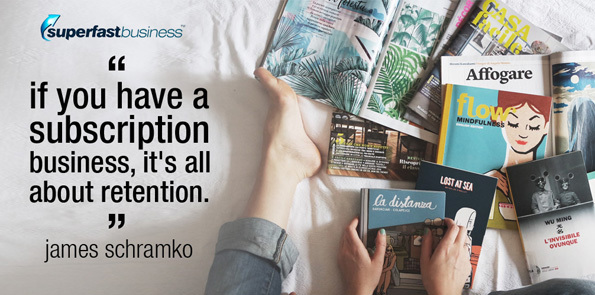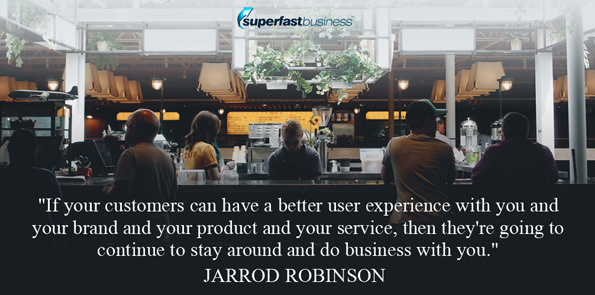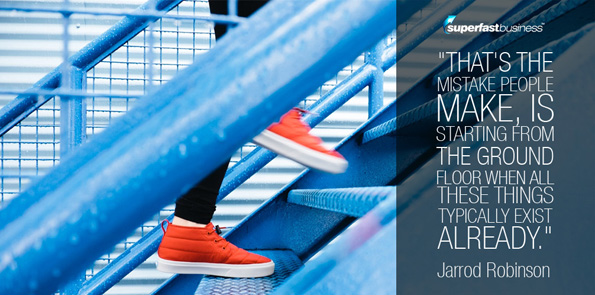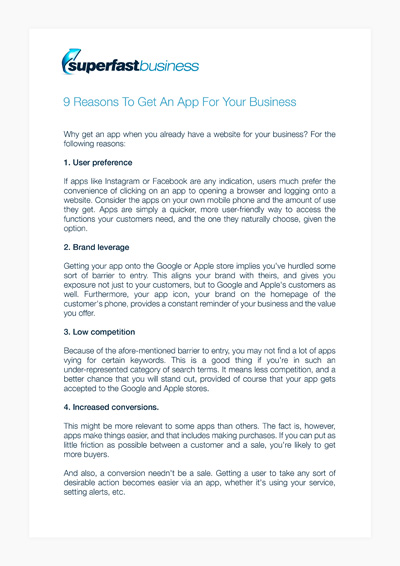Podcast: Download (Duration: 20:40 — 19.1MB)
Get Notified Of Future Episodes Apple Podcasts | Spotify | Amazon Music | Android | Blubrry | Gaana | TuneIn | Deezer | Anghami | RSS | More
In the podcast:
01:37 – What do users prefer?
03:57 – Leveraging a brand
05:37 – Not a lot of competition
08:18 – Getting more conversions
11:35 – It works offline
13:13 – Leveraging device capabilities
14:42 – The name of the game is retention
16:43 – An enhanced experience for users
17:51 – Amazing speed
Keep your business timely and in touch with the market with help from James
Transcription:
James: James Schramko here. Welcome back to SuperFastBusiness.com. This is Episode 668. We’re talking with Jarrod Robinson from theappmatch.com. Good day, mate.
Jarrod: How are you? Good to be back.
James: Always good to catch up in between nappy changes. You’ve got the young one there, and I do too, now, and we’ve got parenting stories to exchange. And also, we talk a lot about online marketing, and in particular, apps. And recently, you were telling me about the advantages of a mobile app over a website. And we decided it’d be a great idea to record our conversation. Because I still think there’s an awareness gap in the marketplace.
Jarrod: For sure.
James: You know, people have heard about apps, they probably think they know what they are. We’ve talked about them before in our series, we’ve had an ongoing series on SuperFastBusiness, where we cover this topic. But let’s break it down. Just in case there’s any gray area, let’s talk about the nine reasons an app is still a great advantage over the website experience for your customers.
What do users prefer?
Jarrod: Yeah, yeah. Well, I mean, there’s nine, but there probably is more than that. But I think it comes down to these top nine. And the first one, James, you’d be probably aware of this as well. User preference, you know? If you look at our own usage of a mobile phone, in our preparation to get onto this call, how many apps do you think we probably used?
James: Well, yeah. I mean, you probably use more than I do.
Jarrod: Definitely.
James: Generational thing. But I still think there are apps taking up that prime real estate. But I know in any given day, because I actually track and monitor the usage of my phone, I know some apps are getting a pretty good workout, when I look into the reports. And some of them are for pleasure. I might be looking at World Surfing League or a forecasting app. I definitely look at my forecasting app every single day.
Jarrod: For sure.
James: And I’d rather do that than go and look for a browser.
Jarrod: Exactly.
James: And then there’s other apps that we use just as business tools for communication. I did a conference call this morning, and I was a guest. And all I had to do is click on the app to get on to that one, as well. And of course, I use the app that’s on the homepage of my phone to access my own community, which is what a lot of other members do, for some of the reasons we’re going to discuss.
“Having an app is a great opportunity to dive into that main attention.”
Jarrod: Absolutely. And you’ve touched on all the right things. And they make it easy now to see your usage in your own device, whether it’s an Android or iOS, and, you know, I’ve looked at my phone today, and I’ve spent about three hours on it. And if I look at the top-listed apps, they’re actually all apps. And if I go right down to the bottom, like five minutes inside Safari, which is like the mobile web. So a lot of people have their business real estate, the core thing that they’re interacting with and trying to get people to come to. And just based on my behavior for the day and what everyone else does, we’re spending more time in apps. So having an app is a great opportunity to, you know, dive into that main attention.
James: Almost certainly people are using Instagram or Facebook apps on their device, rather than logging into the browser. So that’s probably one of the most easy-to-relate-to apps.
Jarrod: For sure. Yeah, it’s user preference,
James: Right. So user preference, it’s just the easier place to use a website. Like, in my case, they’re using a light or native version of my website, in that app. Same as when using the Facebook app or Instagram, you can still look at Instagram on the browser, but the experience sucks compared to the app.
Jarrod: Yeah. That’s a great-designed app, that can really bring up those benefits and make it even easier for things to happen. And I guess that is the reason why people tend to spend time inside them.
Leveraging a brand
And then it’s onto the second idea. You know, if you’re building an app in this space, it’s not just that, you know, user preference is good. But you get to leverage the brand element of Google and Apple. And I think this is a big thing in itself. Maybe in some spaces more than others, but the fact that it’s such a high barrier to get onto the App Store, and some people aren’t aware of that. But once you’re on there, you get to sort of say, hey, Apple, hey, Google, share your customers with us. Does that sort of make sense? So you get this idea that you’re sort of co-aligned with them, to some extent,
James: It does. I mean, on our web page, we were able to put the Apple and the Google brand logo with a link to our actual app. So it’s a brand association. But I think also, when you’re talking about brand alignment, you’re putting your brand that app brand on the customer’s phone. But for a lot of my customers, my app will be on that front page of real estate of the phone they’re picking up every few minutes, all day long. So that brand alignment with your own brand is there as well. You’re aligning with the big brands, the Google, the Apple, to get onto the device. I liked that you said there’s rigorous criteria, because I’m sure that’s going to lend itself to one of the other advantages. And you can also work hard incorporating your own brand. You’ve got that branding icon right in front of you. Probably one of the most iconic brands that are on my apps that I click on is the F1 app, that is a kick ass brand. It’s so well-known.
Jarrod: Like, over and over sort of, you know, reminding you that it exists. And, you know, I look at your SFB app icon, and I see your face, like on my home screen, over and over every single day. And you just think about, if that’s your brand, and you’re trying to get into your customers and remind them of what you do, it’s a pretty killer strategy for that.
James: Right. And it shares the same kind of logo as my podcast, which has got a good amount of downloads, and it’s just brand recognition.
Not a lot of competition
Jarrod: And it does lead into that next one that you sort of alluded to there as well, that the barrier for entry to this is is quite high. And a lot of people will come to us and say oh, you know, I’ve heard it’s challenging and difficult and can be a long process. And it can be, if you’re not having someone manage it for you. That’s probably the secret there. But that in itself is probably the biggest opportunity. You know, low competition is very prevalent on the App Store. And, you know, at SuperFastBusiness in 2017, you can go and watch the recording in the membership, but I spoke about this in particular related to our PE teaching audience. And you know, if you did a Google search, there was like 100 million websites and articles that came out related to PE teacher. But if you search that in the app stores, there would be a handful of things that would appear. And we actually had six of the top 10 apps that would appear for that search term. But then we were nowhere near being found, related to that search term, online. So the low competition thing meant that we got lots of traction for people using that in that space.
James: Right. It just makes sense. And I know from experience, from your experience, submitting the apps, that from time to time, their criteria that need to be satisfied, that mean the difference between getting accepted or rejecting, there’s no way I would try and put an app out there myself, knowing what I know. I tried it in the beginning, it doesn’t work. I use theappmatch.com for my apps; it’s part of the inspiration for this Tech Talk Series we’ve been running over several episodes now. We’re up to one, two, three, four, five, six, seven episodes, this is the eighth, I think. So we’ve been building a body of work around this concept. But it’s so vitally important.
I love the idea of low competition. I’m sure when people search for business coaching, or as in the case of my business, a lot of people search for the brand or my name, my app will come up. And I like when people visit my site that it can prompt them to get the app if they don’t already have it. And then my app starts to occupy that real estate. I mean, think about how many apps do you have on your phone? And how many make it to the first few pages? Even though there’s a few, there’s nothing like how many websites are online.
“You get the best of the best of the breed bubbling up onto your device.”
Jarrod: No, absolutely. So you get these like, best of the breed bubbling up onto your device. And I think that’s quite good. And especially if you look at the App Store, you know, you can assume that the people who got on there have gone through a rigorous process, because it is quite challenging at times. And hopefully that leads to quality. I mean, it doesn’t mean that all apps are going to be, you know, suiting what you need. But it is a good filter for ensuring that, as opposed to the websites where anyone can create one with wix.com or one of these free tools. And it’s just filled the internet full of low sort of, you know, quality stuff. So it’s a big one for me.
James: Cool. So just to recap, number one was user preference. Number two, brand alignment. Number three, low competition. That puts us at number four, what do we have for that?
Getting more conversions
Jarrod: Increased conversions. And you know, this might be more relevant for some industries. So you know, if you were doing some ecommerce type things or games in particular, but I guess the reason why this is potentially an increasing conversions is because of the frictionless environment of making purchases in that mobile space. I mean, most people listening have probably purchased something via the Apple or Google app stores.
James: I purchase via the Amazon app.
Jarrod: Yeah, so either of those tools work as, like, the intermediary between the developer and you. And then obviously, the developer earns a royalty from that. But how easy is it to make a purchase when you’re getting an app?
James: I like apps where it remembers you. And some of them also, I can use facial ID. So I just hold the app, it lets me login. A trading app that I use for forex does that. And so I don’t have to keep logging in, it can just get me going. Whereas if I had to go and use a browser, log into the website, it’s just more steps. It’s harder. And I think we’ve seen a huge shift. The stats are there to show that there are a lot more purchases being made on mobile devices than several years ago. And if your purchases are being made on mobile devices, then you’d have to think that an app with all the other benefits we’re listing gives you that increased conversion advantage.
“Getting people to take any sort of step is easier to do.”
Jarrod: For sure. Yeah, absolutely. Because like you said, it remembers you, it can store that data in almost like an offline state, and you can be permanently logged in as opposed to a website where that sort of stuff tends to disappear with cookies, and so on. So you get different conditions. And if it’s easier for you to make that purchase with, you know, Apple Pay, and all the other integrations that Apple and Google are sort of making in their ecosystem, then it just makes it easier to convert. And that doesn’t just mean conversions in a monetary sense. But getting people to take any sort of step is easier to do. Like you said, getting people to check, what is it, a surf report?
James: Yeah. So each day I can look at the cameras for all the local beaches near me. And I can look at the wave height, I can look at the tide chart, the first light, end of light, the temperature of the water, and the wind conditions, like live and anticipated. And from that, I can work out where I should be surfing, what time I should be surfing, which board I’ll be taking and which wetsuit. And it’s all driven from the app.
Jarrod: Yeah, it’s awesome. And you can think about that, if their goal is to get people to check those things, the app goes a long way to making those little conversions happen to get people to do those actions.
James: I can set alerts. So if the wind and the waves are a certain size and direction, it can trigger an alert. So I get this alert pop through and it says, smooth wave alert, or something – you can you can name it whatever you want.
Jarrod: Awesome.
James: And I’ve got different alerts set for different conditions. So I could actually get an alert on my phone that tells me, drop everything, it’s the best it’s going to get. Like, it’s amazing what you can do with the app. You and I’ve been going through the baby phase lately. The app that you put me on, it helps you indicate where your baby’s up to developmentally and what sort of changes they’re experiencing. This education, it wasn’t there years ago. So it’s a fantastic tool.
Jarrod: It’s been pretty right on, too, every time we’ve looked at the app and the material that it’s sort of sending to us. And it sent us an alert that was very much in conjunction with what we were noticing, which is pretty cool.
James: Right. So basically, the message here is, use your alerts. I think that’ll come up in a future point as well.
It works offline
Let’s talk about number five, because this one’s an interesting one.
Jarrod: Yeah, I mean, a lot of people like this idea of being able to potentially work offline in certain situations. And before we got on the call, you were talking about, you’re doing some brain training at the moment,
James: Yeah, I use an app called Peak.
Jarrod: And you can do that potentially offline.
James: You can do it offline. And that’s important, because the internet is not so great here. You know, I can go online and check my scores and update it, but it’ll still work if I don’t have internet. That means I could use it on an airplane.
“Everyone’s walking around with smartphones these days that carry gigabytes of potential storage.”
Jarrod: Yeah. So you get the ability to use the onboard devices storage. So everyone’s walking around with smartphones these days that carry, like, gigabytes of potential storage.
James: More technology than took man to the moon, more likely.
Jarrod: Exactly. And with an app, you can dive in to use that infrastructure, as opposed to just the website, where you sort of need a connection, and you don’t really get to be able to do that stuff. So yeah, you get to be able to do your brain training while you’re on the train. And, you know, for someone in our PE teacher space, they can download their training videos, their webinars, to offline, so that when they’re out and about, they could be listening to it without using up all their internet. And that doesn’t seem like a big deal for the always-connected world, but you’d be surprised how many people sort of get behind that concept.
James: Well, as a traveler, I can tell you, it can get pretty expensive and difficult to be always connected. First thing you want to do is switch off all those background things. I mean, one of the apps on my phone, Dropbox, uploads my cameras. Anything, any picture I take or video, it uploads it to Dropbox, and it can be brutal on the Wi-Fi. So you gotta be careful about those things.
Leveraging device capabilities
Jarrod: Yeah, and this flows into the next one, too. They sort of connect with each other. So you know, being able to work offline, it almost leads into number six, which is also being able to leverage the device capabilities. So being able to take pictures in the app or use the GPS to tell you locations, or you mentioned, like, face ID type stuff for security. All of these inherent functions that, like you said, are far more powerful than what took people to the moon. The developers who build apps, like us, can build things that actually interact with that, and you end up with, like, this Swiss Army knife of possibilities.
“As things change, your app will need adjusting.”
James: Yeah, it’s really good. And that’s something, look, it’s worth mentioning at this point, things change. You know, the phone I had before this, I don’t think it had the facial recognition. So as things change, your app will need adjusting. And that’s why, get professional help. TheAppMatch.com will do all of this for you. I’ve asked you for a couple of changes lately, because one of the video players that I use on my site was not being as friendly as it used to be, so it needed an update. I don’t know how to do it. But I do know how to email Jarrod.
Jarrod: Yeah. That reinforces this idea that it does change. Like, the third party that we used to show you a video in app, they changed. So what happens is you have to react to that. And it’s a constant.
James: So it’s not something you do yourself. It’s something you get help with.
Jarrod: For sure.
James: But once you’re doing that, like anyone who’s not getting help or doesn’t have an app, I mean, they’re out of the game already. I’m on the bleeding edge of app now. Hands-free, really. So, where are we up to?
Jarrod: Number seven.
James: Oh, that’s probably my favorite, Jarrod.
The name of the game is retention
Jarrod: Seven’s retention rate.
 James: Retention rate, that is the name of the game. If you have a subscription business, it’s all about retention. Because if you can keep customers, you don’t need to go find new ones all the time. And most definitely, that was the biggest gain we had when we turned on the app.
James: Retention rate, that is the name of the game. If you have a subscription business, it’s all about retention. Because if you can keep customers, you don’t need to go find new ones all the time. And most definitely, that was the biggest gain we had when we turned on the app.
You know, I didn’t expect much. And I mentioned this in our previous episodes. I didn’t think it would be that big a deal. Jarrod’s very enthusiastic – “You should have an app. It’s great.” I’m like, okay, yes. All right, well, let’s do it. And boom, people say, “I love this app, I’m using the app.” I get such great feedback from it.
Jarrod: And we know when we make changes and do the wrong thing that people tell us, too.
James: Oh, they tell us straightaway. There was the famous roll back once, I think. Okay, let’s put the old one back. But that’s part of innovation. And it’s a business situation where you’re not always going to have everyone happy. Even when, I think, I noticed the Facebook app went to a lighter shade of blue the other day.
Jarrod: Yeah, definitely.
James: So, always changing. But with retention, we noticed people are using my membership more. More people logged in more often, and more people stick around. That is a fantastic reason to have an app right there. If you have any kind of subscription program where they use the app to access it, this is a winning move.
Jarrod: For sure. And just the ability to send behavioral-based push notifications. I know you’ve spoken about push before, and you know how powerful they can be. But being able to send them around the things that people are doing, like you said, your weather reports – like, the phone knows the weather, it knows the conditions of where you’re hoping to surf, and it’s able to tie that up with things that you’ve suggested and stored and send you a push alert, to bring you back into the app to then have you go off and do whatever it is that you’re hoping to do. So all that sort of stuff just means that you’re more likely to continue using their tool.
James: Yeah, and, and just for any old salties here who worry about that I’m too technologically dependent, I still use visuals. I’ll walk to the end of the street and have a look at the conditions. I’ll do a drive in the car, and double-check it, you know? Nothing substitutes for the real life. But if you want to know the weather tomorrow, or the next day, just ask a surfer, they’ll tell you all about it.
An enhanced experience for users
Next, we have number eight.
 Jarrod: Yeah, improved user experience. And I think if you summed up a lot of the stuff that we’ve been talking about, it does lay down the path for an improved user experience that your customers can have. If your customers can have a better user experience with you and your brand and your product and your service, then it probably leads into that last one, James, they’re going to continue to stay around and do business with you. And you know, a lot of the stuff that is possible on a website can still make this user experience quite good for your customers. But there are some inherent opportunities that we’ve mentioned today that really take that to a whole new level that, you know, is something that people should explore.
Jarrod: Yeah, improved user experience. And I think if you summed up a lot of the stuff that we’ve been talking about, it does lay down the path for an improved user experience that your customers can have. If your customers can have a better user experience with you and your brand and your product and your service, then it probably leads into that last one, James, they’re going to continue to stay around and do business with you. And you know, a lot of the stuff that is possible on a website can still make this user experience quite good for your customers. But there are some inherent opportunities that we’ve mentioned today that really take that to a whole new level that, you know, is something that people should explore.
James: This really fits in the design category. It’s about designing a great experience for your customers. Usability is vital. Whether you’re doing SEO, whether you’re doing copywriting, whether you’re laying out a membership, everything, the brand, the look, the feel, the pictures, the logos, they all combine to make a user experience. So the trend that we found, especially on the latest app update (we call it a push, right?), was to remove features – have the simplest, leanest possible version of the app. And that was creating a really good user experience. Kind of lends itself to point number nine, actually.
Amazing speed
Jarrod: Absolutely. So by doing that, we actually help people get the results that they come to you for – all the forum, all your coaching, all that wrapped up in a device that keeps them logged in, they don’t have to go to their website. So, improved user experience was there, but it was just so much faster. Like, literally, if I open my phone up now and click on your app tile, for the SuperFastBusiness app, I am now looking at the private coaching thread inside of the app, and I could, like, post a question. I haven’t had to login; I haven’t had to remember a password and try and you know, make sure it loads. Like, it was literally just there waiting to go. And that’s something that apps have over websites all day.
James: It’s amazing. I mean, literally James in your pocket. If you click on the logo, and you type something in your private coaching, ask me a question, I answer it. I’m using the app on the other end. That’s the beauty of it. As the product owner, I’m using the same device. So there’s that very fast ability to communicate and get advice, to find out opinions, to sounding board things, to check links, those sort of things, your coach in your pocket. That’s what the app’s brought for my business. I’m really pleased that we’ve been able to go down this path and make it work so well. We also have one for SilverCircle, which is pretty much a sister app. It’s the same type of application now that we found the winning formula for us.
So for a quick recap, Jarrod, the nine advantages are: user preference, brand alignment, low competition, increased conversions, work offline, leveraged device capabilities, retention rate, improved user experience, and speed. And all of this is available from TheAppMatch.com. If you want to find an app that suits your existing business, Jarrod’s already got it. He already has the app. He’s got all different types. And that’s what the whole match part of The App Match is, he will match an existing app to your business and customize it, the look and the feel, to make sure that it works. So you don’t have to go and spend $50,000 and design an app from scratch and get it in a year and a half from now. You can get started straight away.
 Jarrod: That’s the mistake people make, is starting from the ground floor when all these things typically exist already. And we’re really good because we were doing it for our own needs of finding what people do or sell or help people with, and thinking, well, how can we package up into an app? And you sort of mentioned, you know, it’s like the app match, isn’t it? Like, that’s a brilliant name. That’s what we do.
Jarrod: That’s the mistake people make, is starting from the ground floor when all these things typically exist already. And we’re really good because we were doing it for our own needs of finding what people do or sell or help people with, and thinking, well, how can we package up into an app? And you sort of mentioned, you know, it’s like the app match, isn’t it? Like, that’s a brilliant name. That’s what we do.
James: Perfect. Jarrod Robinson. So this is part of The Tech Talk Series. This is Episode 668. Always open to comments. If you love the show, leave a review on iTunes. Check out Jarrod’s site at theappmatch.com. Always a pleasure to catch up, Jarrod. Thank you so much for sharing.
Jarrod: We’ll speak soon.
Stay on the leading edge of business technology inside JamesSchramko membership
Get the perfect app for your business from theappmatch.com
Liking the show? Leave us a review on iTunes











Very informative article! Thanks so much for taking the time to write such a comprehensive article. I think I got all the information I was looking for. Thanks for this wonderful piece of article.
In spite of the fact, that the list of these benefits can be endless, as an expert in the Web & Mobile Application Development area, I can define one of the major ones – any mobile app is intended to use on the go, which makes it available for you anytime no matter where you are.
In spite of the fact, that the list of these benefits can be endless, as an expert in the Web & Mobile Application Development area, I can define one of the major ones – any mobile app is intended to use on the go, which makes it available for you anytime no matter where you are.